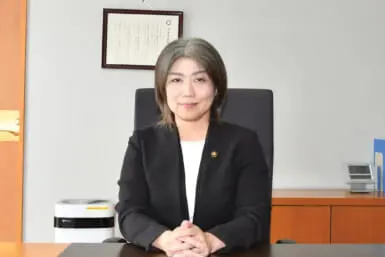by Elyse M. Rogers
ST. LUKE’S HOSPITAL—TODAY AND TOMORROW
As many of you know, St. Luke’s has planned to build a new hospital for quite some time now, so recently I went to — talk with St. Luke’s Director, Dr. Makino, to get current information on the new structure to pass on to you.
Dr. Makino took over as director shortly after building plans had already begun. But since planning and implementing a huge new project takes a great deal of time and effort, Dr. Makino has been the guiding force behind the current revised plans.
You may remember reading in this column that at one time the timetable for completion of the new St. Luke’s hospital was 1988. Well, that obviously didn’t materialize, mainly because the original plan was projected to be too costly to operate. So, it was literally back to the drawing board, with lots of changes and a new project plan and a new timetable.
REVISED HOSPITAL COMPLEX
The hospital will not be the only new building built on the land adjacent to St. Luke’s. In order to support the hospital building and help pay its running costs, two other buildings will be completed on the site: an office building (in which they hope to have medically related companies renting space), and a condominium complex for older people, which will have an in-house medical clinic and a nurse on duty 24 hours per day.
Whenever new buildings are contemplated, there are many problems in getting permits, neighborhood cooperation, etc. And, as you might expect, with such a big plan as the St. Luke’s complex, there are many small and large problems to work through before the whole project is approved and ready to go.
One of the biggest difficulties has been getting the cooperation of the residents in the neighborhood who are concerned about the problems of sunlight, increased traffic, etc. However, those negotiations have been going along well and most people have been very cooperative, according to the doctor. Dr. Makino also stated that they’ve been fortunate in that the people in the neighborhood are fond of St. Luke’s and arc therefore trying to be helpful in getting the new hospital established.
The old hospital was built in 1933 so, although it’s still functional, “it’s getting old,” according to Dr. Makino. One big problem is the piping system which is under constant repair, but cannot be permanently fixed.
Although a spanking new St. Luke’s hospital will be wonderful. I was delighted to learn that the chapel connected to the old hospital will be retained. (It’s beautiful, folks. Even if you’re not Episcopalian or even religious, stop by the hospital and see it. It’s a lovely, sacred, peaceful place, right in the middle of the hospital and the city itself.)
It is hoped that building can begin on the new structure either by the end of 1988 or early in 1989. And, it’s projected to take two-to-three years to complete. Just in case you’re into numbers, the cost of the new hospital is estimated to be “at least ¥30 billion” (or a whopping U.S. $230 million).
LAYOUT AND PATIENT PHILOSOPHY
There are so many new and exciting features of the new hospital, that it’s hard to know where to begin the list. And I can’t possibly cover all the new innovations. But to name a few primary ones, both physical and psychological:
1) All private room system. Can you believe it? This hospital will be built with private rooms only. Dr. Makino said that this was decided upon for many reasons, not the least of which was a patient survey showing that most patients preferred private rooms. Lest you think this a frivolous, economically unsound plan, let me assure you that saving money was a major reason for this private-room decision. “It’s difficult to have full occupancy if you must separate patients by sexes, by habits (non-smoking versus smoking), by disease conditions, etc. However, if all the rooms are private, any empty room can be immediately filled by any type of patient.” In addition, it’s hoped that the private rooms will be a reason for patients to choose St. Luke’s as their main hospital.
Although it will be some time before the new hospital will be completed and I’ll be able to visit and see their functioning private rooms, I did get a kind of preview glimpse. Set up in one of the older, adjacent buildings to the hospital, they’ve installed two “sample private rooms” complete with lights, bedtables, bathrooms, closets and everything. So I got a chance to walk inside. “The rooms are small.” Dr. Makino warned me, but I really didn’t find them so. One is the “standard room” for which there will be no extra charge for patients under Japanese national health insurance, and the other is a larger room for which there will be an additional charge. Both size rooms have a window, too.
2) Small waitine areas. Instead of the one huge waiting area that now exists in St. Luke’s — and, indeed, in most hospitals in Japan — smaller, cozier waiting areas near the specific area of specialty will be the rule.
3) A new “Primary Nursing” system. Perhaps this should be called the “My Patient” system. As Dr. Makino explains it, “If I, as a doctor have a patient, it is my patient and I see that patient through his/her stay. But the patient is assigned to varying nurses during that same stay.” With the new system, however, the patient would have a designated nurse as well as a designated doctor for more continuity of care. Kind of a neat concept, wouldn’t you say?
4) Choice of food. Most Japanese hospitals serve one meal to all patients (varying with special diets, of course) but there is no selection offered. With some food choices, the doctor believes both the nutrition of the patient and the morale of the patient will improve.
5) Fiber optic system. A coding system throughout the hospital to make record keeping easier to do and faster to retrieve.
6) And more. There’s also a new drug delivery system planned, a special materials management program and many other special features. I’ll report on all of those when the new hospital is functional.
THE OLD HOSPITAL
New is exciting, but let’s not forget the existing hospital which has served both foreigners and Japanese well for its long history. (Although not in the same building, the hospital itself dates back to 1902.)
As I reported last time, wonderful English-language signs are everywhere, making it so much easier for the foreigner to find his way around the building. Need to go to otolaryngology? No need to get lost in a sea of unreadable kanji; merely look below and it’s literally spelled out for you.
PATIENT LANGUAGE SERVICE
But now there’s another new feature for foreigners which is totally subarashii (wonderful)! This is called the Patient Language Service. And, it’s exactly what it sounds like—a place for foreigners to get English-language help with forms, questions, anything relating to outpatient care at St. Luke’s.
This is the type of service I’ve asked so many hospital directors to institute, with so little success that I guess I’ve given up thinking it would happen. But it has! Since the language problem is one of the most frightening problems for foreigners needing medical care (and the one I get questions about most frequently), I congratulate and heartily thank St. Luke’s for this important new service. I know you’ll all join me in giving Dr. Makino and his staff well-deserved applause.
On the lighter side, I was talking with St. Luke’s special volunteer (and definitely one of their most valuable assets) Eleanor Honaman who wondered if the name “Patient Language Service” was perhaps too cumbersome. “Do you think we should have just called it ‘Information Desk?'” she asked me. I hastily assured her that the name was just fine, Eleanor is bi-lingual, (and at the hospital on Wednesdays, by the way), so she’s probably forgotten how difficult it is for new foreigners who don’t speak or understand Japanese. But I remember with painful clarity back to my English-only days in Japan when I approached countless numbers of clearly-marked-in-English hospital “Information Desks” and found out quickly that it was Nihongo dake!
I should also mention that the out-patient department also provides registration forms in English and an English-language pamphlet which lists the clinic departments, services and contains a chart showing the steps from registration to cashier and prescription drug pick-up.
St. Luke’s official address is in Akashi-cho, but most of us think of it “in Tsukiji.” And the easiest way to get there is to get off at Tsukiji Station on the Hibiya Subway Line, (The Shintomicho stop on the Yurakucho Subway Line is also pretty close.)
St. Luke’s International Hospital, 10-1 Akashi-cho, Chuo-ku, Tokyo 104, Phone 541-5151.








